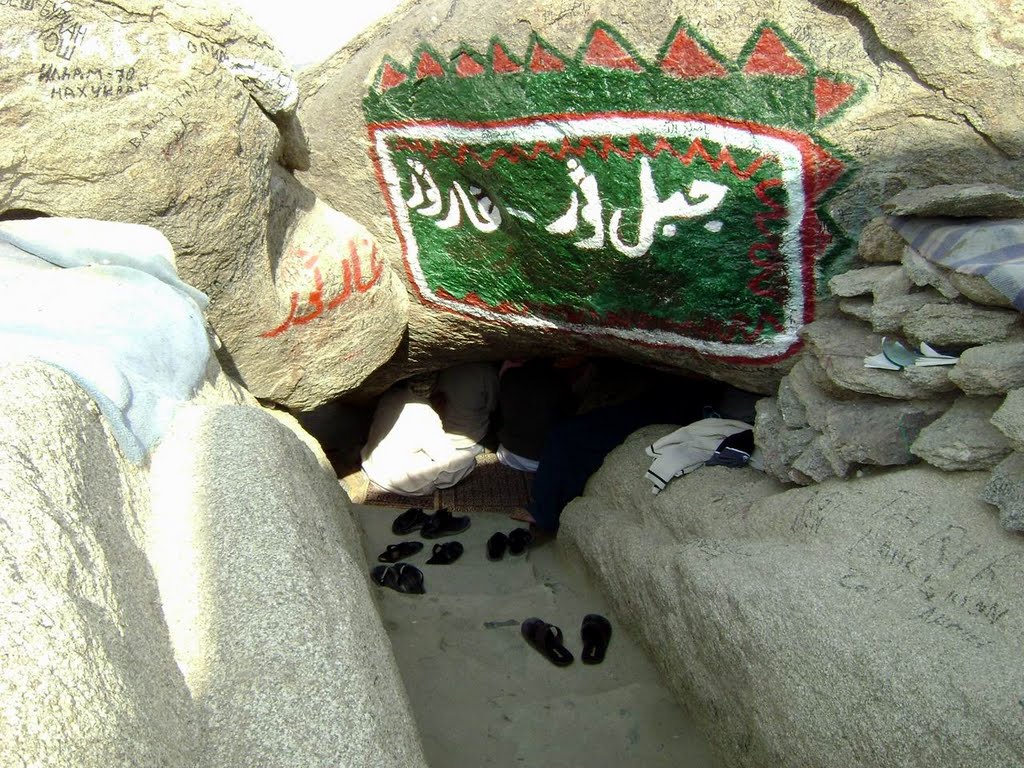Jabal Thawr is a famous mountain in Saudi Arabia, located in the lower part of Makkah to the south of the district of Misfalah. The height of the Jabal Thawr is 2,460 ft. A noteworthy historical and religious site situated approximately four kilometers from the Grand Masjid. Those who successfully ascend to the pinnacle of Thawr are rewarded with expansive vistas and a glimpse inside the cave.
The mountain is distinguished holy place due to housing a cave known as Ghār Thawr, in which the Islamic prophet Hazrat Muhammad (PBUH) took refuge from the Qurayish, during the hijrah (migration) to Medina. It is also known as the Cave of Thawr, Ghar Thawr and Ghar-e-Soor.
The Muslims believe, the cave is of religious significance, and is thus visited by many pilgrims and tourists. Mount Thawr is located 5 miles (8.0 kilometres) away from Makkah. It is unknown how old the cave actually is. But given that it is a natural cave, its age is probably in the thousands. It is believed that Hazrat Muhammad (PBUH) stayed here as a refugee with his beloved companion Hazrat Abu Bakr al-Siddiq (R.A).
At the entrance to the cave, Allah (SWT) sent a spider to construct a web, shielding the two men from the enemy’ ability to see inside and locate them. This web kept the Abu Jahal soldiers from entering the cave, preventing them from being apprehended. Afterwards, Thawr Cave has come to represent optimism and faith. The location receives fewer pilgrims than Hira Cave in Jabal Al Noor, where Prophet Muhammad (PBUH) received his first revelation, due to its greater distance from the holy city.
Jabal Thawr is really a steep mountain. It is not recommended for anyone with mobility issues or any form of back difficulties. Climbing takes two hours for a physically fit person and four hours for everyone else. The ascent of the mountain is dangerous due to the hard rocks.
In Islam, the history of Ghar-e-Soor is very significant. The Prophet faced insults and mistreatment when he condemned the worship of idols and warned the idolaters of Makkah about the repercussions of their disbelief. The Quraish treated the Prophet and his adherents horribly after this. They then made the decision to go to Yathrib, which is now known as Madina. The Prophet Muhammad (PBUH) was just about to travel with his companion Hazarat Abu Bakr (R.A.) when the Quraish army fiercely chased them. The Prophet’s head was marked with a bounty, and the idolaters of Makkah promised rewards to anyone who captured him—dead or alive. Around this time, soldiers surrounded the Prophet Muhammad (PBUH), forcing him to seek refuge in the Cave of Thawr. The entrance to the cave was so small that it could only be entered by crawling. Hazrat Abu Bakr’s son and daughter went to the cave during this period to provide the evacuees food and drink. For this reason, the history of Ghar e Soor plays a significant role in the history of Islam.
When Hazrat Abu Bakr (RA) arrived to Ghar al-Thawr, he asked Prophet Muhammad (PBUH) to wait outside while he went inside the cave to clean it. Hazrat Abu Bakr (RA) removed anything that would harm the revered Prophet Muhammad (PBUH) while he was at it. Abruptly, a snake that Hazrat Abu Bakr (RA) had unintentionally left exposed slithered out of the hole and stung the companion on the foot.
Hazrat Abu Bakr (RA), nevertheless, remained motionless despite the intensity of the anguish because he was afraid he would awaken Prophet Muhammad (PBUH). However, in the great affection movements, the tears started to fall down Hazrat Abu Bakr’s (R.A.) cheeks as he endured the pain patiently; eventually, they fell upon Prophet Muhammad’s (PBUH) face, causing him to awaken. Prophet Muhammad (PBUH) applied his saliva to Hazrat Abu Bakr’s (RA) wound, curing the venomous bite miraculously while he watched in agony. They spent three days and nights in the cave of Jabal Thawr together.
The Prophet Muhammad (PBUH) and his companion did not have an easy time during their stay at Ghar e Saur, also referred to as the Thawr cave. Nevertheless, in spite of all the difficulties and hardships, the two of them were able to successfully elude the Quraysh warriors and remain hidden. The Cave of Thawr is a site of great religious significance, and many Muslims visit it every year. It is a well-liked tourist destination that sees a lot of traffic from travelers coming to Makkah to complete their Hajj or Umrah pilgrimages.
Read More: Jabal Al-Noor – The Mountain of Light in Makkah










